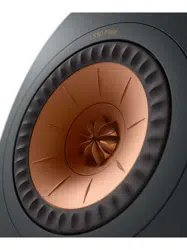Loading ...
Loading ...
Loading ...

10 11
Appendix 1 - Cabinet
The cabinet construction follows closely that of the
original LS50.
Diffraction
Diffraction is the secondary radiation that happens
when the wavefront from the driver meets a sharp
edge. This reradiation causes what might be described
as a mini-echo that time-smears the driver’s output.
The effect varies with angle, but needs to be minimised
to maintain clarity.
At very low frequencies, rather like a sea wave
wrapping round a small pebble, the sharp edges of
the cabinet have little effect - the sound simply wraps
around the object in a smooth manner. At very high
frequencies, only a minimal proportion of the energy
travels along the front bafe, due to the increased
directivity of the radiating diaphragm, and the
reradiation level is low. In between these extremes,
the shape of the cabinet, especially the front bafe,
has a marked effect.
Traditionally, it was thought that the edges of the bafe
need to be rounded, preferably with a radius similar
to the wavelength of the sound. However, detailed
research has shown that, if the bafe is curved, the
angle at the edge does not have to reach 90 degrees.
for the majority of the diffraction effect to be
eliminated. This is extremely fortunate, because fully
rounding the corners with a large radius is wasteful of
space and not very nice to look at. The front bafe is
curved in both directions enough to make diffraction
inaudible.
Rigid Bracing/Constrained
Layer Damping
The ultimate goal in the design of any speaker is to
have all the sound energy coming from the drivers
and none from anything else. The cabinet walls are a
particular problem as they have a much larger area
than the driver diaphragms and their output can be
problematic with relatively little exure. Not only is
the sound delayed relative to the direct sound from
the drivers, but it’s highly distorted and the resulting
colouration can be extremely unpleasant.
Vibration of the cabinet walls is excited both by
variation in air pressure inside the cabinet and by the
reaction force on the driver motor as the diaphragm
moves back and forth. This latter force is transmitted
via the driver chassis to the cabinet panel.
That the cabinet needs to be there at all may be
realised by going back to gure 2. The bass/midrange
driver radiates energy to the rear and that energy
has to be contained, otherwise the rear radiation
will progressively cancel the front radiation as the
frequency decreases, and absorbed - which effectively
means turning it into heat.
This constraint has traditionally been done by adding
bracing. On its own, this has less effect than may be
expected from simply considering static stiffness.
What it tends to do is shift the problem to higher
frequencies. However, the simple expedient of adding
a lossy layer between the braces and the cabinet
walls absorbs far more energy - Constrained Layer
Damping. This lossy material is sandwiched between
the bracing and the driver/panel, converting vibration
into heat.
Specication - LS50 Meta
Description
Bookshelf Loudspeakers
Drive Units
Uni-Q™ Driver Array
LF/MF: Nominal dia. 130mm (5.25 in) magnesium/aluminium alloy cone
HF: Nominal dia. 25mm (1 in) aluminium alloy dome vented with
Metamaterial Absorption Technology (MAT)
Frequency Range (-6dB) 47Hz - 45kHz
Frequency Response (±3dB) 79Hz - 28kHz
Sensitivity (2.83V, 1m) 85dB SPL
Maximum SPL at 1m 106dB
Harmonic distortion <0.4% 175Hz - 20kHz (90dB SPL, 1m)
Crossover frequency 2.1kHz
Nominal Impedance 8Ω
Minimum Impedance 3.5Ω
Dimensions (inc. terminals) H: 302mm (11.9 in)
W: 200mm (7.8 in)
D: 278mm (10.9 in)
Weight 7.2kg (15.8 lb)
Written specications like these, however useful for comparison, do not fully describe the listening experience.
However good the component parts, voicing the system with the crossover is all-important.
The following graphs, which include additional directivity and early reection information in line with the
research work of Floyd Toole [9] [10], show how smooth the response of the LS50 Meta is, indicating a superb
listening experience.
Figure 27
Low-diffraction Bafe
Loading ...
Loading ...
Loading ...
